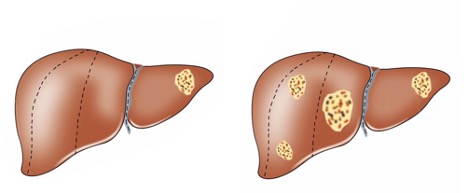Liver Cancer
The liver is one of the most important organs in your body: It breaks down food into energy and rids your body of substances that could harm you. When cancer cells are growing inside the liver, it’s called liver cancer.
Types of Liver Cancer
Doctors classify liver cancers into two categories:
- Primary liver cancers are tumors that develop directly from liver tissue.
- Secondary, or metastatic, liver cancers are tumors that start in another part of the body, such as the colon, then spread to the liver.
The most common primary liver cancers include:
- Hepatocellular carcinoma: This cancer commonly (but not always) coincides with liver disease (or a cirrhotic liver) and is related to:
- Chronic alcohol use
- Chronic hepatitis
- A diet high in fatty foods
- Gallbladder carcinoma: Found in gallbladder tissue, this cancer often causes no obvious symptoms until advanced stages.
- Cholangiocarcinoma: This cancer is found in the bile ducts, which are the tubes around and inside the liver.
Metastatic Liver Cancer
 The most common tumors we find in the liver are metastatic cancers that originated
in another organ.
The most common tumors we find in the liver are metastatic cancers that originated
in another organ.
Several different types of tumors can spread to the liver. These include:
- Colorectal cancer, which grows in the intestine lining
- Sarcoma, which develops in the bones or connective tissue
- Adrenal tumors, which start in the adrenal glands (above your kidneys)
- Renal carcinoma, which develops in the kidney
- Neuroendocrine tumors, which grow from the body’s endocrine (hormonal) cells
Diagnosing Liver Cancer
Liver cancer is most commonly found on an imaging test, such as a CT or MRI scan, that someone receives for a completely separate reason. Once doctors spot a liver mass, or lesion, they will likely recommend other diagnostic tests to figure out whether the mass is benign (noncancerous) or malignant (cancerous).
Treating liver cancer in a multidisciplinary approach is the key to achieving the best outcomes. We discuss each case with our oncologist, radiologist, gastroenterologist and surgeons to determine the best treatment plan for each patient. Surgical intervention is a hallmark of treatment when a cure is potentially possible and it may include minimally invasive or conventional resection of parts of the liver and biliary tree. In the case of colon cancer spreading to the liver the treatment of choice is often surgery. The liver is the only organ in the body that can regenerate, so as long as 20 percent of the liver remains after surgery, it can regrow and retain functionality. If the tumor is so large that it requires more than 80 percent of your liver to be removed, doctors may consider using a procedure called preoperative embolization, which blocks the blood supply to a portion of the liver and tumor. This essentially starves the tumor and shunts blood to the healthy liver to stimulate liver growth and allow surgery to be safely performed.
When you have cancer of your colon that spread to your liver your doctors may recommend to remove the tumors from your colon and your liver at the same operation or to perform two separate operations.